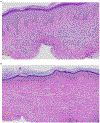Xenograft Skin Model to Manipulate Human Immune Responses In Vivo
- PMID: 35848826
- PMCID: PMC10552904
- DOI: 10.3791/64040
Xenograft Skin Model to Manipulate Human Immune Responses In Vivo
Abstract
The human skin xenograft model, in which human donor skin is transplanted onto an immunodeficient mouse host, is an important option for translational research in skin immunology. Murine and human skin differ substantially in anatomy and immune cell composition. Therefore, traditional mouse models have limitations for dermatological research and drug discovery. However, successful xenotransplants are technically challenging and require optimal specimen and mouse graft site preparation for graft and host survival. The present protocol provides an optimized technique for transplanting human skin onto mice and discusses necessary considerations for downstream experimental aims. This report describes the appropriate preparation of a human donor skin sample, assembly of a surgical setup, mouse and surgical site preparation, skin transplantation, and post-surgical monitoring. Adherence to these methods allows for maintenance of xenografts for over 6 weeks post-surgery. The techniques outlined below allow maximum grafting efficiency due to the development of engineering controls, sterile technique, and pre- and post-surgical conditioning. Appropriate performance of the xenograft model results in long-lived human skin graft samples for experimental characterization of human skin and preclinical testing of compounds in vivo.
Figures




References
-
- Zomer HD, Trentin AG Skin wound healing in humans and mice: Challenges in translational research. Journal of Dermatological Science. 90, (1), 3–12 (2018). - PubMed
-
- Mestas J, Hughes CCW Of mice and not men: differences between mouse and human immunology. The Journal of Immunology. 172, (5), 2731–2738 (2004). - PubMed
-
- Pasparakis M, Haase I, Nestle FO Mechanisms regulating skin immunity and inflammation. Nature Reviews Immunology. 14, (5), 289–301 (2014). - PubMed
Publication types
MeSH terms
Grants and funding
LinkOut - more resources
Full Text Sources
